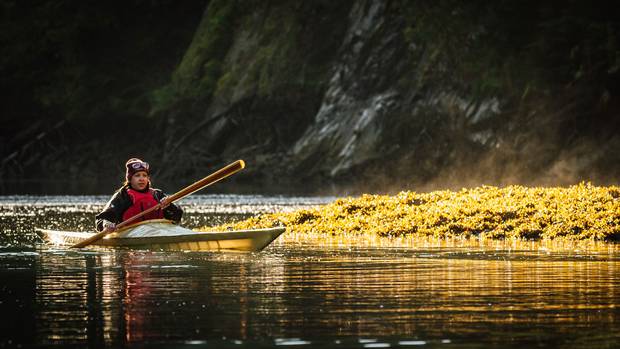Cyndi Peal had no intention of going anywhere.
She was merely standing at the Prince Rupert wharf in early October to watch the docking of the Polar Prince as the C3 Expedition neared the final destination of its 150-day cruise around the three Canadian coastlines.
Her cousin, Hemas Tlalalitla Bill Wilson, an elder of the Kwakwaka'wakw Nation, was on board the refurbished icebreaker and Ms. Peal merely wanted to say hello and catch up on family news.
Mr. Wilson was one of several special guests – writers, musicians, scientists, entrepreneurs, indigenous leaders – joining the Polar Prince for various legs of the 15-segment voyage celebrating the country's 150th anniversary. As one of the most respected First Nations leaders along the West Coast, the father of Canadian justice minister Jody Wilson-Raybould had been an obvious choice for the organizers to invite along on the first segment to reach B.C. waters.
Ms. Peal never would have expected an invitation. The 45-year-old member of the Nisga'a Nation works part-time as a deckhand on a small fishing boat she operates out of Bella Bella with her fiancé, Herman White of the Heiltsuk Nation. "I'm not a big shot," she says. "I'm not a spokesperson." She had enough trouble getting her partner of six years, her two daughters, son and four grandchildren to listen.
But she got talking to some of the participants and they told her they'd be visiting Haida Gwaii in the days to come. She mentioned that all her life she had wanted to see the majestic totem poles of the famous islands.
"How soon can you be packed?" she was asked.
It was, for expedition leader Geoff Green, a fortuitous encounter. A previously invited indigenous leader had just cancelled. Cyndi Peal might not be well known, but she had knowledge of the B.C. coast as a second-year student in the province's Coastal Stewardship Technician Program. She also has, he quickly noted, "this amazing spirit."
Ms. Peal decided on the spur of the moment to go. She had less than a day to pack and make arrangements. "I'm smart," she thought, "I'm fun and I like boats. I like travelling and meeting new people and trying new things. So yes, I'll go."
She thought she was sailing to Haida Gwaii. She was really about to take the internal voyage of her life.
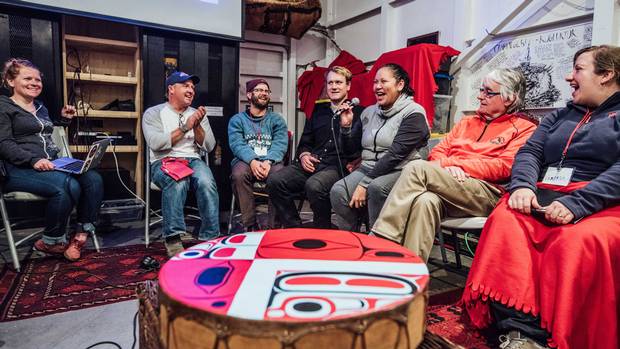
Cyndi Peal, shown laughing with a microphone in her hand, got a new perspective on reconciliation and her identity during her time with the Canada C3 expedition. ‘The trip allowed me to grow in ways I never thought I would – or could imagine with a group of people I had never met.’
'I am glad we have such strong survivors'
Ms. Peal is fiercely proud of her aboriginal heritage, but also acutely aware of realities. Her parents, Ron Peal and the late Elaine Price, met at residential school in Edmonton, hundreds of miles from their West Coast homes and families. Ms. Peal attended regular school on Vancouver Island and in Vancouver but was bullied and discriminated against. She sought refuge in sports, where she excelled in track and field and swimming.
From the outset, reconciliation had been a stated goal of the C3 Expedition. Ms. Peal admitted to having "mixed feelings" about such a do-good mission.
"I hold anger, confusion, hurt, sadness, frustration," she says. "I also hold a great deal of pride in being part of a next generation. I am glad we have such strong survivors."
Living in Prince Rupert means living next door to Highway 16, the notorious "Highway of Tears," a place where multiple – no exact number is known – indigenous women have joined the chilling list of murdered and missing women.
Ms. Peal is close to families directly affected by the loss of a mother, sister, aunt, cousin. She will only go out at night in company of someone she trusts. When walking, she carries her mobile phone like it has been drawn from a holster.
One evening on this trip she and another participant with an indigenous background, Kalie Ulriksen, would conduct a vigil on the ship in memory of the lost women.
Ms. Peal is also acutely aware of the historical tensions in B.C. between the First Nations and the Europeans. She had just turned 13 in the fall of 1985 when the Haida people set up a blockade to prevent logging on Lyell Island.
It was a conflict long in the making: old-growth forest depletion against sustainable resource management, white justice and values against aboriginal land rights – and the Haida were not backing down. With tensions running high, the police came and arrested 72 people, beginning with elders Ethel Jones, Watson Pryce and Ada Yovanovich.
"The television images of elders being arrested really struck me." she remembers 32 years later. "I was crying and crying. I couldn't believe this was happening."
The logging stopped. The Haida, who had never come to treaty agreement with Canada, had a critical victory and were keen for more. They eventually took the name "Queen Charlotte Islands," put it in a special ceremony box and hand delivered it to then Premier Gordon Campbell, telling him to send the name back to the Queen.
Their islands would be known henceforth as Haida Gwaii.

A totem pole at the Haida Heritage Centre at Kay Llnagaay. Adventure collectors of the Victorian area took many of the Haida’s cultural heritage, and sometimes the remains of their dead, to faraway museums.
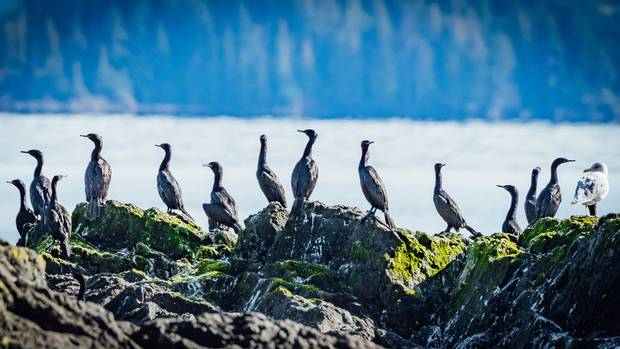
Cormorants near Kay Llnagaay. Haida Gwaii was once home to as many as 30,000 Haida, but when European settlers brought smallpox in the 1860s, that population plummeted to fewer than 600. There are about 5,000 people on the islands today.
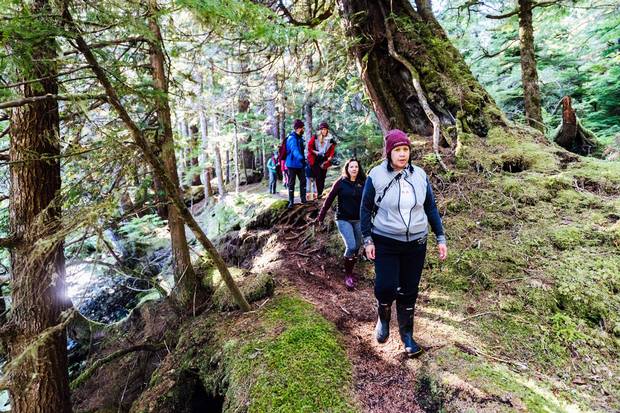
Cyndi Peal and other Canada C3 voyagers explore the moss-covered forests of Gwaii Haanas National Park Reserve and Haida Heritage Site. The Haida share authority over the site with Parks Canada, though not always enthusiastically.
An uneasy arrival, an improbable connection
The Canadian flag and the flag-painted boat had been cheered at stops along the previous 12 stages, but this segment would test those fuzzy and warm feelings toward the federal government's birthday celebrations.
As Cam Hill, a Gitga'ata leader and school principal at Hartley Bay put it: "It's difficult for us to celebrate Canada's 150th. We welcome you to our community, but we do not welcome your project."
At Skidegate, where the Polar Prince made port, there was a panel discussion regarding the Gwaii Haanas National Park Reserve, National Marine Conservation Area Reserve and Haida Heritage Site, which the expedition would visit the following day. Parks Canada and the Haida share authority, but not with great enthusiasm.
Cindy Boyko, who has represented the Haida interests on the board for the past 17 years, told the gathering that, "It hasn't been easy working with the government of Canada. We don't trust the government…so we are diligent every step of the way. Government talk feels too tricky to us… "We've had to learn to co-manage. We've evolved. It has not been easy."
Later, when she and others took a tour of the museum, Ms Peal was overcome by emotion. She learned that there was once as many as 30,000 Haida living along the shores of these emerald islands. She learned that the Europeans brought smallpox in 1862 and within short years the Haida numbered less than 600.
It was not just lives the Europeans took but the very bones of those who died. The rich Haida culture was ransacked by the obsessive adventurer collectors of the Victorian era, the Haida's beautiful poles and artifacts and, in many cases, even their remains taken away to far off museums and collections.
For more than four decades now, the Haida have fought to repatriate the remains of those taken away as curiosities. More than 500 have now been brought home for burial, the most recent only two days before the arrival of the Polar Prince.
Watching a video of Haida elders talking about the importance of retrieving their property and the remains of their ancestors, Ms Peal broke into tears.
She went for a walk to clear her mind and eyes and found herself entering the village of Skidegate. She asked a man whose house had an incredible view of the harbour if she and others from the ship might come onto his porch to take photographs of the scene.
They got to talking and the man told his family history, mentioning his sons and how his late wife had come from Cape Mudge on Quadra Island.
This seemed an improbably coincidence, Ms Peal thought. "My mother was from Cape Mudge!"
A little more talk and they established that they were related, distant cousins.
Ms Peal could not get the coincidences or the connections out of her head.
She felt, for the first time, that perhaps she was supposed to be on this journey she had fallen into by accident.
Awe and introspection on Haida Gwaii
The Polar Prince sailed for Gwaii Hassan and the expedition made shore by four Zodiacs, Ms Peal sitting alongside Guujaaw, the 64-year-old elder and leader who served as president of the Council of the Haida Nation from 2000-2013.
Guujaaw, a large lion of a man, talked about the 1985 standoff, where he was one of the main and most militant activists. The Canadian and international media called it a "blockade" he says, but it wasn't – "it was Haida standing up for our rights. We weren't there to be non-violent; we were there to stop the logging, whatever it took.
"We weren't mad. We enjoyed it."
Guujaaw is proud that he spent more than a dozen years as head of the First Nation and never had an office. "I never wanted to be a manager," he says. "I'm more a freedom fighter."
Guujaaw was joining the trip to HIk'yah GawGa (Windy Bay) so that he could show the "legacy" totem pole he recently built with his sons to ensure the Haida never forget the great victory at Lyell Island.
"We have never surrendered title," he says. "That is what you would have to do for a settlement. We won't do it."
Later, the group moved along to SGang Gwaay Linagaay, a sheltered bay where a vibrant Haida village once stood. Considered a sacred site by the Haida – and declared a national historic site by Canada – the mossy remnants of foundations and collapsed roofs of loghouses can still be found, with multiple ancient totem poles still standing, their colours long lost to sun and windburn.
Strong emotion again struck Ms Peal as she walked among the ruins and tried to imagine what the village had been like in its prime, with fishing boats landing and children playing.
Something welled up inside her and she burst into loud, agonizing sobs. Sira Chayer, a videographer with the expedition, wrapped her arms around Ms Peal and held her until the crying stopped. Others then helped her down to the beach, where she sat on a log and stared out over the water for a long time.
These first few days of the 10-day voyage were all about reflection for Ms Peal. She spent one afternoon kayaking along the still waters between islands, grew tired, stopped paddling and began to sing Nisga'a songs. She remembers thinking how nice it would be to see some whales and, to her great delight, when the Zodiac was taking her back to the ship several humpback whales put on a remarkable and close display of surfacing, spouting and diving.
On Gribble Island she stood, with remarkable calm, as a "spirit bear" fed on dying salmon in the river and then, without the slightest fear, walked out of the water and along the very path that Ms Peal and others had been standing, watching.
Spirit bears are important in West Coast indigenous oral histories. Some believe the rare bears are the colour of ice and snow, reminders of times past, of hardship and survival.
"I was in awe," she says of the moment the spirit bear ambled past her as if she wasn't even there.
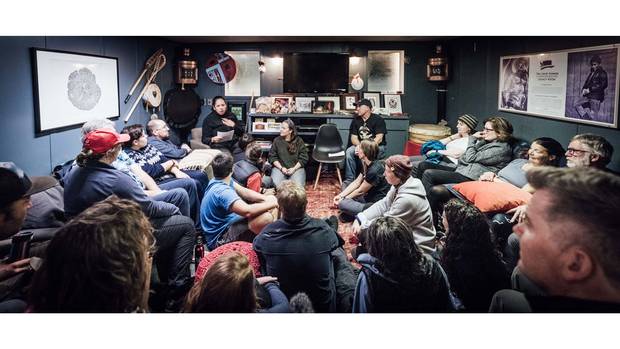
Cyndi Peal and others talk reconciliation in the Polar Prince’s ‘legacy room,’ named in honour of Chanie Wenjack, an Ontario Ojibwe youth who died in the 1960s escaping residential school, and Gord Downie, the late frontman of the Tragically Hip.
'I became who I am meant to be'
There were no factions aboard this leg of the C3 Expedition, no arguments. The evening "sharing" circles fell apart quickly as participants made it clear they'd rather gather informally and socialize over a beer or glass of wine. Perhaps it was because this leg featured so many stops – sometimes two and three a day – and people wanted to dwell on the present rather than the past.
Where the serious talking did take place was in the small communities – mostly indigenous – where the Polar Prince made land and the participants visited schools and community centres.
And the lead speaker, quickly established, was the very person who thought she had nothing to say, no right even to be on board: Cyndi Peal. Unlike other participants who had offered prepared and professional PowerPoint talks on everything from oil spills to the Paralympics, Ms Peal did not have so much a scribbled index card. She spoke from the heart.
She began each talk in her own language. She explained how her Nisga'a name means "Stone Eagle." In English, she told of her work on the fishing boat, her parents finding each other despite the horrors of residential school, her own experiences in school and life and the importance of family and respect for elders.
She found her voice.
And she surprised herself by speaking more and more about reconciliation.
"Take time to support each other," she told the people of Hartley Bay, "through all the hurt, pain, suffering and healing. This will allow us to replace the negative with more positive."
Three weeks after she left the Polar Prince, Ms Peal considered the journey a "spiritual voyage" for herself. It had profoundly changed her.
"I have a positive feeling for where we are now compared to 10 years ago, or 20 or 30 years ago. I have real hopes and expectations for all of our people.
"I became who I am meant to be," she said. "The trip allowed me to grow in ways I never thought I would – or could imagine with a group of people I had never met."
On a ship she never intended to board.
HAIDA GWAII: MORE FROM THE GLOBE AND MAIL
